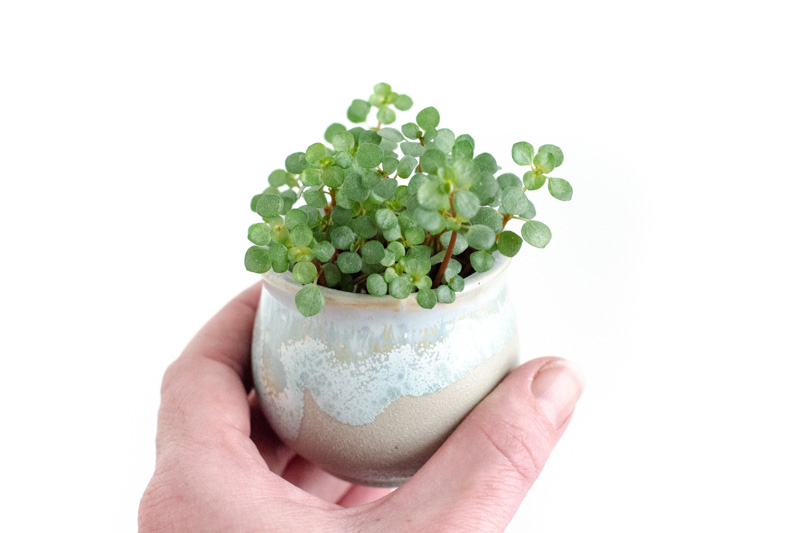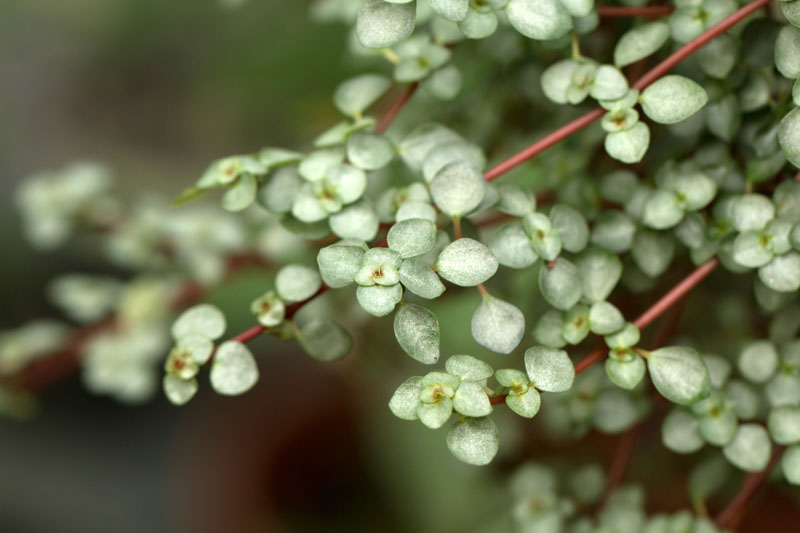Silver Sparkle Pilea, Gray Artillery Plant, Artillery Plant, Pilea Silver Sparkles, Pilea Aquamarine, Pilea libanensis
Pilea glauca, also known as Silver Sparkle Pilea or Gray Artillery Plant, is a captivating small houseplant cherished for its delicate and dense foliage.
Pilea glauca stands out with its tiny, round, blue-gray leaves that cascade down its stems, creating a soft, textured appearance. It’s known for its fast-growing, trailing habit, which makes it a popular choice for hanging baskets and terrariums.
Native: This plant is native to Central and South America, thriving in the understory of forests, and enjoys a warm and moist environment. It belongs to the nettle family (Urticaceae) and is part of a diverse genus with over 600 species.
Plant Type and Habit: This evergreen perennial is characterized by its ground-covering and trailing growth habit. It’s particularly well-suited for indoor environments where its small stature and dense foliage can be appreciated up close.
Size: Pilea glauca is a compact plant, typically reaching heights of 4 inches (10 cm) with a spread extending to 12-24 inches (30-60 cm), depending on the growing conditions and container size.
Flowers: It produces tiny, inconspicuous flowers that are not the main attraction of the plant. The blooms may appear throughout the year under optimal growing conditions but are often overlooked due to the plant’s striking foliage.
Foliage: The small, round, silver-blue leaves are the main feature of Pilea glauca, providing a unique texture and color that complements other houseplants well.
Hardiness: Pilea glauca is best grown in USDA hardiness zones 10-11 if planted outdoors, but it is predominantly cultivated as an indoor plant due to its sensitivity to cold.
Uses: Its trailing habit and dense foliage make it ideal for hanging baskets, terrariums and as a ground cover in indoor garden arrangements. It can also add a delicate texture to mixed plantings.
Toxicity: Pilea glauca is generally considered non-toxic to pets and humans, making it a safe choice for homes with animals and children.
Invasiveness: This plant is not considered invasive and is well-behaved in indoor settings.
Benefits: Beyond its ornamental appeal, Pilea glauca can help purify the air indoors and improve humidity, contributing to a healthier living environment

Caring for Silver Sparkle Pilea (Pilea glauca) is relatively straightforward, making it an excellent choice for novice and experienced plant enthusiasts.
Light: Silver Sparkle Pilea prefers bright, indirect light but can tolerate medium light levels. Avoid direct sunlight, which can scorch the delicate leaves. A spot near a north or east-facing window is ideal.
Soil: Use a well-draining potting mix, ideally one that’s peat-based with added perlite or vermiculite, to ensure good aeration and moisture retention without becoming waterlogged.
Water: This plant likes consistently moist soil but is susceptible to root rot if overwatered. Allow the top inch of soil to dry out before watering again. Reduce watering in the winter months when growth slows.
Humidity: Pilea glauca enjoys high humidity but can adapt to average home humidity levels. For increased humidity, mist the plant regularly, place it on a pebble tray filled with water or use a humidifier.
Temperature: Maintain indoor temperatures between 60-75°F (15-24°C). Avoid exposure to cold drafts and sudden temperature changes, as Pilea glauca is sensitive to cold.
Fertilization: Feed with a diluted, balanced liquid fertilizer once every month during the growing season (spring and summer). Do not fertilize in the fall and winter when the plant’s growth naturally slows down.
Pruning: Pruning is not typically required for health reasons but can be done to maintain the desired shape and size or to encourage fuller growth. Use clean, sharp scissors to trim back any leggy stems.
Propagating Silver Sparkle Pilea is straightforward and can be an enjoyable way to expand your collection or share with friends.
Choose Healthy Stems: Choose a healthy stem from your Pilea glauca with several leaves. Look for robust stems that show no signs of pests or disease.
Cut: With your clean, sharp scissors or pruning shears, cut a piece of stem about 2-4 inches long. Ensure your cutting includes at least one node (the point on the stem where leaves are attached), as roots will develop from these nodes.
Prepare: You can dip the cut end of the stem in rooting hormone to encourage root growth, but this step is optional as Pilea glauca roots relatively easily.
Water Method: Place the cutting in a small container or glass filled with water, ensuring the node is submerged but the leaves remain above water. Place the container in a bright spot with indirect light. Change the water every few days to keep it clean. Roots should begin to form in 2-4 weeks.
Soil Method: Fill a small pot with a well-draining potting mix. Plant the cutting in the soil, ensuring the node is buried. Water lightly to settle the soil around the cutting. Place the pot in a bright spot with indirect light and keep the soil consistently moist but not waterlogged. Roots should develop in a few weeks, at which point you can begin to care for it like a mature plant.
Aftercare: Once roots have formed, and you’ve seen new growth, you can care for your new Silver Sparkle Pilea as you would the parent plant. If you started in water, transplant the rooted cutting into a pot with well-draining soil.

Silver Sparkle Pilea is generally easy to care for, but like all plants, it can encounter pests, diseases, and common problems.
Spider Mites: These tiny pests can be identified by the fine webs they weave on the plant. They cause yellowing or speckled leaves. Increase humidity around the plant and wash it with a strong stream of water. For severe infestations, use insecticidal soap or neem oil.
Mealybugs: These white, cottony pests tend to cluster in leaf axils and under leaves, sucking sap and weakening the plant. Remove with alcohol-dipped cotton swabs or apply neem oil.
Scale insects: Hard or soft-bodied insects that attach themselves to the stems or leaves, causing yellowing and growth stunting. Scrape off with a fingernail or use a cotton swab dipped in rubbing alcohol. Insecticidal soap or neem oil may also be used.
Aphids: These small, green pests suck sap from new growth. Rinse them off with water or treat the plant with neem oil.
Root rot: Can occur if the plant is overwatered or if the potting mix does not drain well. Symptoms include yellowing leaves and a mushy stem base. Prevent this by ensuring good drainage and letting the top inch of soil dry out between waterings.
Powdery mildew: Might affect the leaves in high humidity with poor air circulation, appearing as white powdery spots. Improve air circulation and treat with fungicide if necessary.
Leggy Growth: Insufficient light can cause the plant to stretch towards the light source, resulting in leggy stems. Ensure your Pilea glauca receives bright, indirect light to maintain compact growth..
Dropping Leaves: This can be a sign of either overwatering or under-watering. Adjust your watering schedule to ensure the soil remains evenly moist but not soggy.
Fading Leaf Color: Direct sunlight can bleach the leaves, while too little light can cause them to lose their vibrant color. Position your plant in a spot with bright, indirect light for optimal foliage color.

Yes, Pilea glauca, like many tropical plants, thrives in environments with high humidity. It originates from tropical areas where the air is moist. In a home setting, this plant appreciates humidity levels of 50% or higher. Low humidity can lead to crispy edges on leaves, slow growth, and increased susceptibility to pests like spider mites. To increase humidity, you can mist the plant regularly, use a pebble tray with water, place a humidifier nearby, or group it with other plants.
Several factors could contribute to your Pilea glauca’s decline:
Overwatering or Underwatering: Pilea glauca likes its soil to be evenly moist but not waterlogged. Overwatering can lead to root rot, while underwatering can cause the plant to dry out and wilt. Ensure the pot has good drainage and allow the top inch of soil to dry out slightly before watering again.
Lack of Humidity: If the air is too dry, Pilea glauca may struggle to thrive. Its leaves might become crispy and brown at the edges.
Insufficient Light: While Pilea glauca does well in bright, indirect light, too little light can weaken the plant, leading to leggy growth and poor health. Conversely, too much direct sunlight can scorch the leaves.
Pest Infestation: Pests such as spider mites, mealybugs, and aphids can stress the plant, causing it to appear as if it’s dying. Regularly inspect your plant for pests and treat it with insecticidal soap or neem oil as needed.
Temperature Stress: Extreme temperatures, either too hot or too cold, can adversely affect Pilea glauca. It prefers a consistent temperature range between 60°F to 75°F (15°C to 24°C).
| Hardiness |
10 - 11 |
|---|---|
| Plant Type | Houseplants, Perennials |
| Plant Family | Urticaceae |
| Genus | Pilea |
| Exposure | Partial Sun |
| Season of Interest |
Spring (Early, Mid, Late) Summer (Early, Mid, Late) Fall Winter |
| Height |
3" - 4" (8cm - 10cm) |
| Spread |
1' - 2' (30cm - 60cm) |
| Maintenance | Low |
| Water Needs | Average |
| Soil Type | Loam, Sand |
| Soil pH | Acid, Neutral, Alkaline |
| Soil Drainage | Moist but Well-Drained |
| Characteristics | Showy, Evergreen |
| Garden Uses | Hanging Baskets, Patio And Containers |
| Hardiness |
10 - 11 |
|---|---|
| Plant Type | Houseplants, Perennials |
| Plant Family | Urticaceae |
| Genus | Pilea |
| Exposure | Partial Sun |
| Season of Interest |
Spring (Early, Mid, Late) Summer (Early, Mid, Late) Fall Winter |
| Height |
3" - 4" (8cm - 10cm) |
| Spread |
1' - 2' (30cm - 60cm) |
| Maintenance | Low |
| Water Needs | Average |
| Soil Type | Loam, Sand |
| Soil pH | Acid, Neutral, Alkaline |
| Soil Drainage | Moist but Well-Drained |
| Characteristics | Showy, Evergreen |
| Garden Uses | Hanging Baskets, Patio And Containers |
How many Pilea glauca (Silver Sparkle Pilea) do I need for my garden?
| Plant | Quantity | |
|---|---|---|
| Pilea glauca (Silver Sparkle Pilea) | N/A | Buy Plants |
Create a membership account to save your garden designs and to view them on any device.
Becoming a contributing member of Gardenia is easy and can be done in just a few minutes. If you provide us with your name, email address and the payment of a modest $25 annual membership fee, you will become a full member, enabling you to design and save up to 25 of your garden design ideas.
Join now and start creating your dream garden!
Create a membership account to save your garden designs and to view them on any device.
Becoming a contributing member of Gardenia is easy and can be done in just a few minutes. If you provide us with your name, email address and the payment of a modest $25 annual membership fee, you will become a full member, enabling you to design and save up to 25 of your garden design ideas.
Join now and start creating your dream garden!